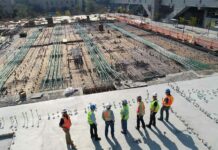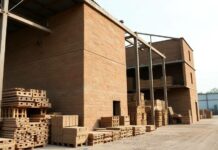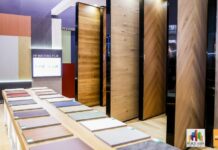As our global consciousness towards environmental impact heightens, the construction and roofing industry is emerging as a pioneer of transformation. For any type of building the roof is really what helps make it overall more eco-friendly. Today we are going to discuss the wonderful world of roofing and its move towards more sustainable solutions for a better and greener future.
Understanding Construction and Roofing
Construction, particularly in architectural design and infrastructure, is a broad field with a multitude of complexities. Roofing, as a significant component of construction, has evolved over the years. From the days of primitive thatched roofs to the modern usage of materials like asphalt shingles, clay tiles, and metal sheets, the transformation has been revolutionary. Yet, the journey doesn’t end here; the industry is on the cusp of another major shift toward sustainable roofing.
Sustainability in Construction and Roofing
Sustainability, a buzzword in almost every industry, is equally pivotal in the realm of construction and roofing. It extends beyond just using eco-friendly materials. Sustainability is about looking at each individual piece and asking yourself what improvements can be made in a reasonable way, focusing on energy-saving measures, cutting down on carbon emissions, and encouraging the use of renewable materials. The roofing industry has been especially proactive in this area. It’s adopted a variety of green practices, paving the way for a whole host of innovative and sustainable roofing alternatives.
Current Sustainable Roofing Materials
A host of sustainable roofing materials have come to the fore, each with its distinct advantages. For instance, metal roofing is not only durable but also recyclable, making it a choice option for sustainable building. Wood and slate, while more traditional, are natural and biodegradable.
Recycled shingles made from post-industrial waste offer another sustainable solution, reducing the burden on our landfills. Furthermore, in regions like Springfield and the surrounding areas, solar tiles are an innovative approach for both homes and businesses and have become a more frequently used energy-efficient roofing option. Solar roofs harness solar power while serving the primary function of a roof, oftentimes these roofs look gorgeous and are a massive eye catcher for onlookers as well.
Innovative Technologies and Techniques in Sustainable Roofing
The advent of new technologies and techniques has further catalyzed the shift towards sustainable roofing. Cool roofs, for instance, reflect more sunlight and absorb less heat, reducing energy costs associated with air conditioning. Green roofs or roof gardens, another innovative technique, provide insulation, manage water runoff, and even create habitats for wildlife.
Waterproofing and insulation techniques have also seen improvements, enhancing the energy efficiency of buildings. Incorporating such practices not only promotes sustainability but also increases the overall lifespan of the roofing system.
Trends and Future Directions in Sustainable Roofing
The roofing industry as a whole is approaching sustainability in an intelligent way. Its evolution is made by technological advancements in materials, improving technology for greener solutions, and providing renewable sources of roofing and energy savings for the average home and business owner. One emerging trend is the integration of photovoltaic systems into roofing materials, offering an innovative solution for renewable energy generation.
Furthermore, the industry is witnessing a growing emphasis on life cycle cost analysis. This approach considers not only the upfront cost of roofing materials but also the long-term savings due to factors like durability, maintenance needs, and energy efficiency.
Costs and Benefits of Sustainable Roofing
While sustainable roofing might have a higher upfront cost compared to traditional roofing, the long-term benefits are substantial. They offer significant ROI due to lower energy costs and fewer maintenance needs. Moreover, sustainable roofing materials tend to be more durable, resulting in a longer lifespan and lower lifecycle cost.
The list doesn’t stop there as the environmental benefits of sustainable roofing reduces carbon footprint, conserves energy, and continue to improve over time, which leads us to a brighter and cleaner future as a whole.
Real World Examples of Sustainable Roofing
Several real-world examples demonstrate the successful implementation of sustainable roofing. From residential homes in suburban areas to large-scale commercial projects in metropolitan areas, sustainable roofing is increasingly becoming the norm all across America.
Take the recent developments of commercial and residential in the Midwest of the United States. Including Kansas City, Columbus, and Springfield. Several large scale projects have incorporated green roofing and solar panel systems, reflecting the commitment to sustainability.
As an example, the Home Builders Association of Greater Springfield has shown a remarkable dedication to the principles of green energy in construction. As a leading voice in the local construction industry, they have taken significant strides to promote sustainable practices among their members.
The association believes in the critical role of green energy in the future of construction. The Home Builders Association of Greater Springfield has been very instrumental in driving forward and reaping the benefits of incorporating green energy solutions, such as solar power and energy-efficient materials, into both construction build outs and roofing solutions. They also provide resources and guidance to help builders navigate the transition to more sustainable practices.
Remember that a green roof provides a natural cooling effect, reducing the building’s overall energy consumption. The solar panel system offsets the energy needs, further enhancing the building’s efficiency. These types of projects serve as a testament to the reality and implementation of sustainable roofing, setting a precedent for future sustainable roofing developments for those located in the Midwest and beyond.
For a Greener Future
Sustainable roofing stands as a testament to the construction industry’s ability to adapt and evolve in the face of global challenges. As discussed in this article, there have been ongoing advancements leading to innovation, practicality, and environmental improvements. As we move together towards a better future with green solutions bringing awareness and utilizing materials that will continue to improve will become more and more the norm.
Sustainability is no longer an option, but a requirement for our futures and the roofing industry’s future lies in harnessing the latest in technology innovations. By doing so, this sector will play a massive part in our collective journey towards a more sustainable and energy efficient world.




























